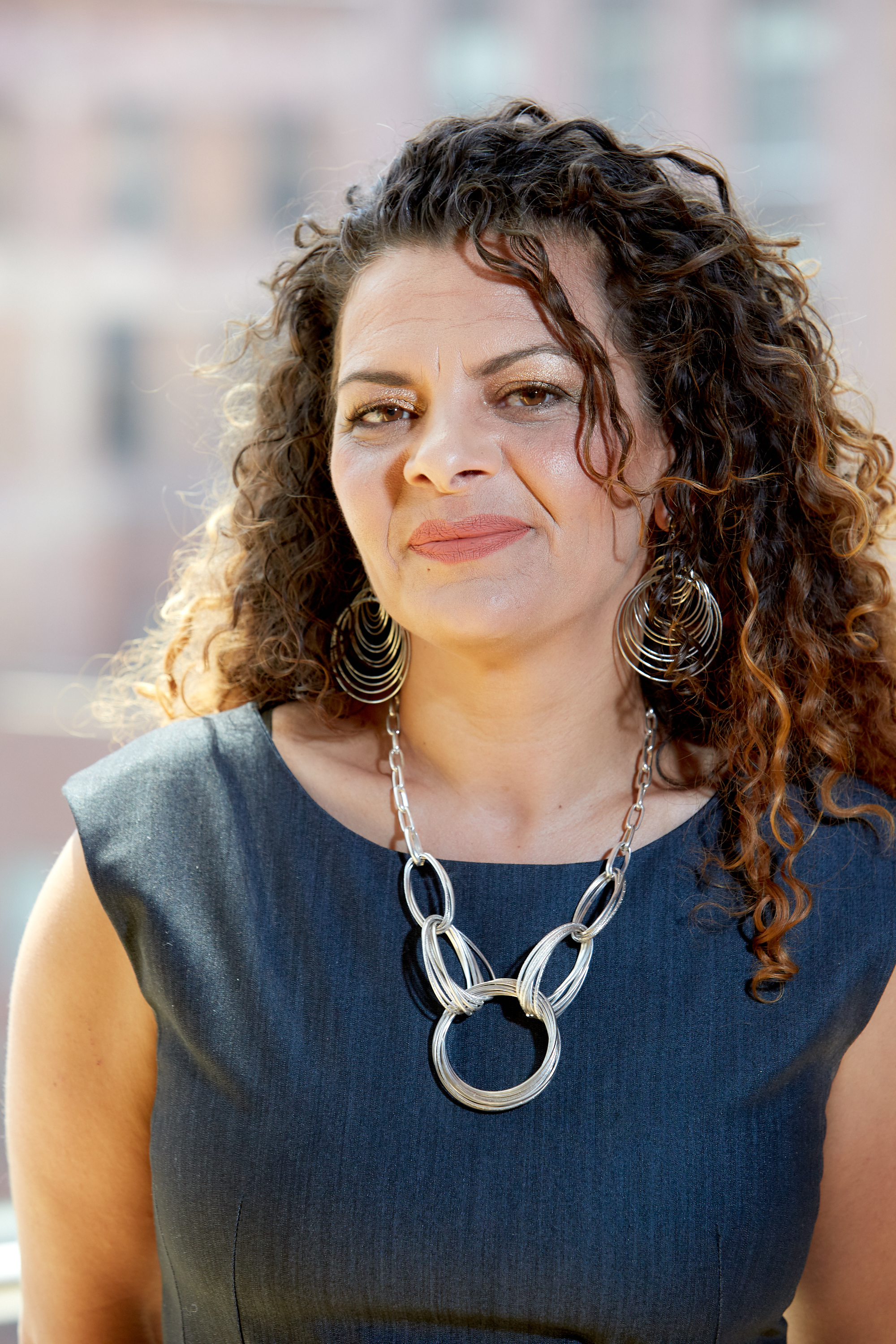Race
&
Identity
Race and identity politics are reshaping our national image. But what roles do they play on a personal level – on our mental health and self-image?
Author: Sam Anderson
Researchers: Jonathan Gray, Silvia Mazzula, Kevin Nadal and Ed Paulino
Artist (above): Sanford Greene
On a campus as diverse as New York City itself, race and identity are subjects not limited to classroom discussion, but rather permeate every aspect of John Jay faculty and students’ daily lives. The politics of race and identity are a driving force behind national discourse and remain subjects of intense interest to faculty like Kevin Nadal, Silvia Mazzula, Ed Paulino and Jonathan Gray, each doing compelling work that expands our understanding of the roles race and identity play in our past, present and future.
As Americans collectively grapple with issues of race and its connection to past and current forms of oppression, it is inevitable that, with increasing frequency, news items bring an aspect of race into sharp enough focus that it sparks a new conversation on the topic. This is what happened in April when two black men were arrested at a Philadelphia Starbucks for requesting a restroom key without ordering anything, prompting national outrage at what was perceived as racial bias.
“As a result, there were lots of news programs that talked about the current state of race and racism, and many of them talked directly about microaggressions,” said professor of psychology Kevin Nadal. “And I think that’s very important, to know that an academic concept that was barely talked about at all is now being talked about on national television and is becoming a commonplace term.”
Bias and Trauma
Much of Nadal’s research focuses on microaggressions, a product of racism or other forms of bias that manifests as slights, snubs, or insults directed at members of a marginalized group. One trait of microaggressions is that they are not always intentional and can be the result of unconscious bias, as opposed to other forms of racism that result from more direct bias.
“Being a person of color and a gay man, I think that’s really been influential in my trying to understand how the world works, and understand how systems have failed certain communities,” Nadal said. “So when I went into psychology, I really wanted to study cultural identity groups that were often invisible or written about way less.”
Nadal’s recent research looks at the impact of microaggressions in trauma. “When people think about trauma,” he said, “they tend to think about events that involve almost being killed, or being sexually assaulted – real heinous types of violence. And when people experience trauma, they develop symptoms of PTSD. For the past 10 or 20 years, researchers have discussed the idea that living under the systemic oppression of everyday racism is actually a cause of similar trauma symptoms – like avoiding certain situations, inability to concentrate, nightmares – and those are all things that we see in populations who experience pervasive discrimination throughout their lives.”
Representation in Academia
As a scholar and advocate, Nadal is working to raise the profile of faculty who don’t match the “traditional” description of a college professor. Along with colleague and fellow associate psychology professor Silvia Mazzula, the #ThisIsWhatAProfessorLooksLike campaign highlights faculty of color through a series of photos and social media posts, some of which have gone viral. “We want to break the stereotypes that professors are these old white guys with tweed jackets,” Nadal said. “In reality, they can be a person of color, and young and queer and trans and an immigrant and all these things.”
According to Mazzula, who spearheaded the hashtag, “what I was trying to do was bring images of what a racial or ethnic minority leader looks like in these spaces. We’re active on social media, posting pictures of Latino men and women with their wonderful titles and credentials, but we also include all the things that make us us: being a first-generation college student, coming from poverty, things like that.”
Mazzula is not only a first-generation college student, but a mother of three; her third child was born just months after she submitted her tenure application. She is working actively to fight the stereotype that raising a family and working in academia are incompatible. Her research, like Nadal’s, looks at the impacts of discrimination, racism and acculturation on mental health outcomes among ethnic minorities. “What my studies have shown is that skin color has a different effect on mental health outcomes for different populations. Some of these outcomes include depression, anxiety, negative outlook on life, and poor perceived health.” One of her current studies aims to discover the relationship between people’s racial identity and the levels of trauma they experience.
In order to help break down the barriers faced by Latina women in higher education, Mazzula founded the Latina Researchers Network, and is currently organizing the Network’s fourth biannual conference, scheduled for the fall. It will bring together scholars, investigators and leaders from across the country to highlight research that’s informing policy and address major issues like immigration, racism and discrimination, with a goal of providing actionable steps toward improvement.
Parsley Massacre
Scholars of race generally acknowledge that issues of race do not exist in a vacuum, but are inextricably linked to other factors such as color, gender, class, and religion. In the course of human history, conflicts over these factors have contributed to countless acts of violence, including war and genocide.
In 1937, Hispaniola – the island comprised of Haiti and the Dominican Republic – was the site of the “Parsley Massacre,” a genocide in which Dominican dictator Rafael Trujillo ordered his troops to systematically murder Haitians and Dominicans with Haitian backgrounds living on the border between the two countries. An estimated 17,000 people were killed.
Today, tensions remain between Haitians and Dominicans, but according to Ed Paulino, an assistant professor of history at John Jay, the history of these two peoples cannot be solely defined by conflict.
Paulino’s recent book is Dividing Hispaniola: The Dominican Republic’s Border Campaign against Haiti, 1930-1961, and it tells a story unfamiliar to many. According to Paulino, Haitians and Dominicans share a rich history of cooperation and peaceful cohabitation, and despite efforts by Trujillo to forge a national Dominican identity in opposition to their Haitian neighbors, this history of cooperation continues to this day.
“What I learned through my research is that unlike the conventional wisdom that assumes, because of recent antagonistic events, that Dominican-Haitian relations had been historically adversarial, my book argues that at the local border level, relations have been more collaborative than adversarial,” said Paulino.
For Paulino, a Dominican-American, the process of discovering this genocide as a college student impacted him in a big way. A young Paulino, who would visit the Dominican Republic with his family and was proud of his Dominican roots, was shocked to learn about a “dramatic campaign of extermination against all Haitians” committed by his own people. The genocide would come to define his life’s work.
“So I’ve written a book about it, I’ve written a one-man show called ‘Eddie’s Perejil,’ I co-founded a social movement to bear witness to these crimes that officially have never been recognized, and more recently, I collaborated on writing a script for a TED-Ed video that explains the massacre,” he said.
Paulino’s TED-Ed video has a half million views online, and Border of Lights, the social movement he co-founded, hosts a yearly event to memorialize the massacre. Today, Paulino continues to perform ‘Eddie’s Perejil’ for audiences on college campuses across the country.
“I think we are expanding the notion of race, and how that plays out,” said Paulino. “And it’s particularly important at John Jay, because many of the students are transnational, they have roots in another part of the world, and many of them are Latino or Dominican. So they’re coming from a different kind of racial experience, which can sometimes overlap with U.S. racialism.”
Rise of the Falcon
Many scholars are paying particular attention to the representation of race, specifically how different racial groups are represented in various forms of media. But while most are looking at traditional forms of media like movies or television, assistant professor of English Jonathan Gray has chosen a more unique form to study: comics. Gray’s forthcoming book Illustrating the Race: Representing Blackness in American Comics tells the story of both progress and setbacks.
Perhaps the most high-profile example of black representation in comics today is Black Panther, a Marvel comics title and recent smash hit film that has been lauded by critics for its progressive portrayal of a black superhero. Gray dedicates part of Illustrating the Race to Black Panther, which traces its roots back to the 1960s when the character was created by famed Marvel Comics editor Stan Lee.
According to Gray, the original portrayal of the Black Panther in the Silver Age of comics was surprisingly ahead of its time. “One of the things he [Stan Lee] takes pains to say is that the Black Panther is the intellectual equal of the super scientists. He’s just as smart as Tony Stark, so that’s huge,” Gray said. “The fact that he’s a ruler, that he’s empowered, he’s a head of state, that’s all pretty radical at the time.”
Gray points to several examples of black superheroes from the ‘60s and ‘70s who are portrayed with varying degrees of nuance, like Storm from X-Men, Luke Cage, and the Falcon, who was Captain America’s partner.
“The Falcon is interesting because he shows up in 1969, which is less than a year after Dr. King is assassinated,” said Gray. “So the Civil Rights movement is happening, and the comic was changed from Captain America to Captain America and the Falcon.”
Gray argues that the portrayal of black superheroes in comics closely follows the timeline of national politics, with a surge of black representation in the late ‘60s and early ‘70s, followed by a backlash during the Reagan years when black superheroes were sidelined. For the Falcon, this meant that after a decade of being a major part of the Captain America comic, he was suddenly removed around 1979, which Gray points out is just one year after the Supreme Court decided Regents of the University of California v. Bakke, striking down aspects of affirmative action as unconstitutional.
According to Gray, black superheroes didn’t return to prominence until after 9/11, but today things seem to be swinging back toward the modes of the 1960s. Some present-day examples are the blockbuster success of Black Panther and the fact that the Falcon has not only returned, but is actually set to become the new Captain America.
“The new portrayals [of black superheroes] ring truer, because they’re more sophisticated. But the foundation is surprisingly strong,” he says. Gray’s book Illustrating the Race is set to be published in 2019.
The various ways John Jay scholarship grapples with questions of race and identity reflect the degree to which questions of race and identity penetrate our society and culture. Nadal, Mazzula, Paulino and Gray have unquestionably inspired other faculty and the public to explore and contribute to the growing conversation, creating a leading role for John Jay in the field.
Photo: Pap Studio

